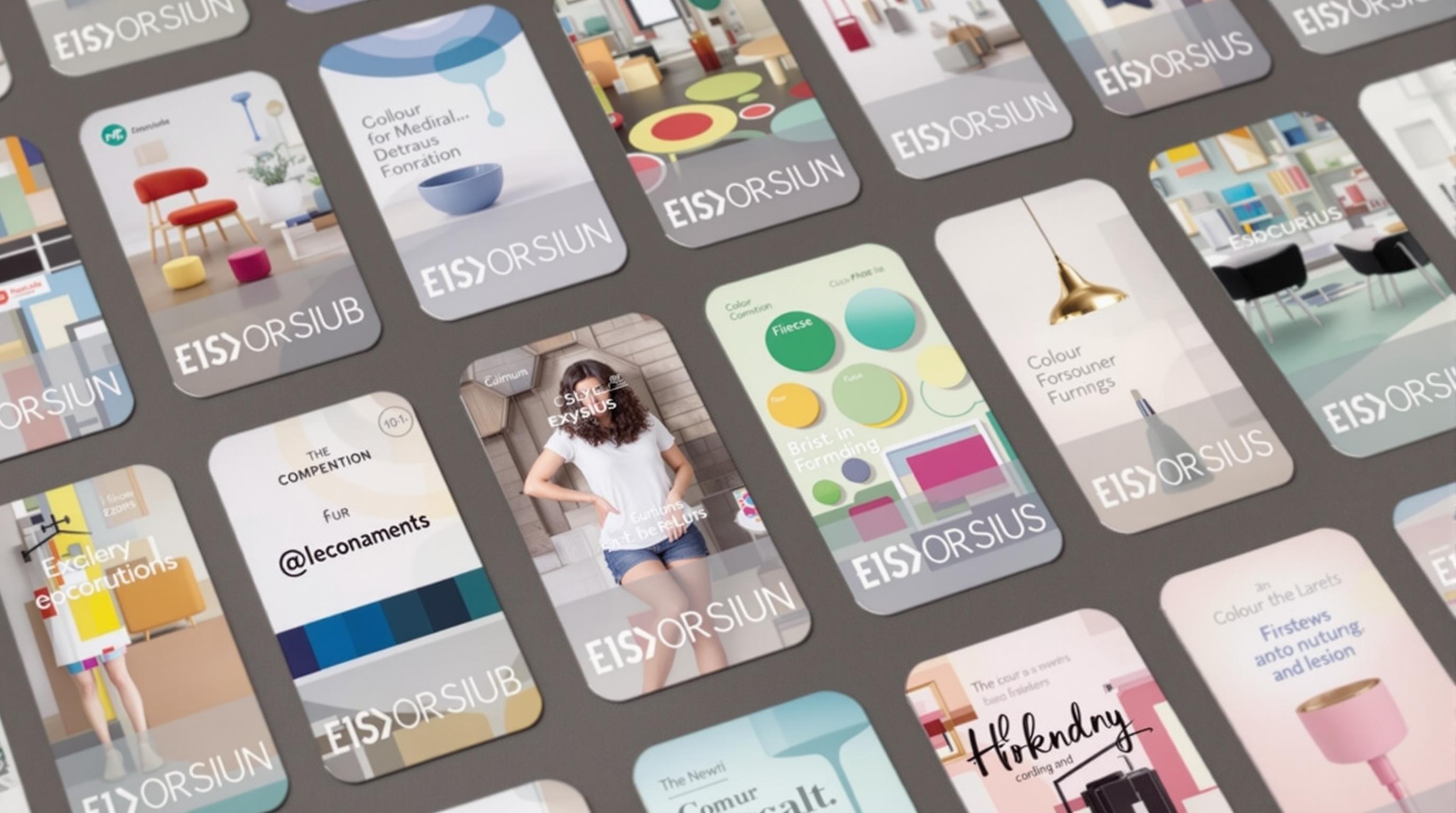Related Articles
- Bizarre Wonders: Crafting Functional Ornaments from Obsolete Household Gadgets and Oddities
- Eco-Chemistry: Innovative Projects Using Upcycled Materials from Your Kitchen for Sustainable Living
- Mystical Metamorphosis: Crafting Enchanted Home Decor from Unwanted Childhood Toys and Forgotten Doll Parts
- Color Cravings: Exploring the Unconventional Links Between Food Choices and Fashion Statements
- Hues of Controversy: The Surprising Ties Between Color Choices and Ethical Consumerism Trends
- Color Waves: Exploring the Impact of Music on Visual Aesthetics in Art and Fashion Choices
9 Hidden Connections: How Color and Style Guides Can Influence Investment Choices and Shape Financial Brand Trust
9 Hidden Connections: How Color and Style Guides Can Influence Investment Choices and Shape Financial Brand Trust
Introduction
In today's digital age, investment choices are not just driven by numbers and market trends; they are also profoundly influenced by visual elements, particularly color and style guides. Financial institutions often overlook the critical role that design plays in shaping customer perceptions and decision-making processes. A well-curated brand utilizing thoughtful color schemes can evoke trust and safety, which is vital in the finance sector.
This article explores nine hidden connections between color, style guides, and their impact on investment choices and brand trust. By delving into psychology, marketing strategies, and case studies of successful financial brands, we can uncover how these design elements interact with consumer behavior. Understanding these connections can provide significant advantages for both investors and financial institutions.
As the finance landscape evolves, so does the importance of these relationships. In an era where competition is fierce and customer loyalty is paramount, recognizing how color and style can communicate values and evoke emotions becomes indispensable for brands striving for success.
The Psychology of Color in Finance
Color psychology reveals that different hues can evoke specific emotions. Research demonstrates that blue, for instance, is often associated with trust and dependability, making it a popular choice for financial institutions. This color choice can reduce perceived risk and enhance customer comfort levels. A study by the Institute for Color Research suggests that people make subconscious judgments about products within 90 seconds of their initial encounter, and 62-90% of that assessment is based solely on color.
Conversely, colors such as red can imply urgency but may also evoke feelings of caution—important traits when it comes to investments and financial decisions. For example, by strategically placing CTAs (calls to action) in a red hue, firms can elicit immediate responses from potential investors while being cautious not to overwhelm them with anxiety.
As brands navigate their visual identity, understanding the psychology of color can serve as a powerful tool in communicating their core values and establishing immediate trust with potential clients.
Consistency and Brand Identity
Style guides formulate the backbone of a brand's identity. Ensuring consistency across visual elements not only reinforces brand recognition but also cultivates customer loyalty. According to a study by Lucidpress, consistent branding across all platforms can increase revenue by up to 23%. Financial brands that integrate their visual identity with their messaging are more likely to resonate with and instill confidence in their audience.
A strong style guide outlines color palettes, typography, and visual components tailored to reflect the brand's essence. For investment firms, this consistency enables customers to develop a mental and emotional association with the brand every time they engage with its materials, whether online or offline.
Furthermore, a coherent brand identity makes it easier for potential investors to internalize the core values of a financial institution, thereby building an overarching framework of trust and reliability.
Case Studies: Success Stories
Examining successful financial brands can provide valuable insights into the implementation of color and style guides. Take the example of American Express, which uses a combination of blue and white within its branding; this choice reinforces notions of reliability and professionalism, thus attracting users seeking trustworthy financial services.
Another notable case is Charles Schwab, which blends welcoming colors like bright oranges and muted blues. This combination not only embodies their commitment to innovation and accessibility but also aligns with their message of making investments approachable and trustworthy for the everyday consumer.
These case studies highlight how thoughtful color choices and consistent style guides can directly impact brand perception, fostering trust while making important financial services relatable and desirable.
Color and Financial Decision-Making
The impact of color on financial decision-making extends beyond mere branding; it influences cognitive processing. A study published in the Journal of Experimental Psychology indicates that colors can trigger different thought processes, thus influencing how individuals assess risk and evaluate choices. Warm colors may stimulate excitement and impulsivity, while cool tones can promote thoughtful deliberation.
For financial brands, this knowledge allows them to curate experiences that guide potential investors along the desired decision-making path. For instance, using calming colors in educational materials can encourage users to take their time and understand conservative investment strategies.
By thoughtfully managing the visual experience, brands can significantly affect how customers perceive their capabilities, potentially leading to more informed and satisfying investment choices.
The Role of Typography
Typography often complements the impact of color by reinforcing the tone and personality of a brand. In finance, readability and professionalism are paramount. If a brand employs an elegant serif typeface, it can convey tradition and trustworthiness. Conversely, a modern sans-serif can signal progressiveness and innovation.
Moreover, typography lends itself to conveying brand messages through specific styles for headings, body text, and calls to action. When paired with a harmonious color scheme, typography establishes a cohesive message. A 2012 study published in the Journal of Consumer Research illustrates that the aesthetic appeal of typography affects consumers' perceptions of quality and credibility.
By curating their typography in alignment with their color schemes, financial institutions can foster a stronger connection with their audience while encouraging a level of trust conducive to informed decision-making.
The Influence of Digital Design
Digital platforms have transformed the way financial brands interact with consumers. The integration of responsive web design, vibrant color schemes, and coherent typography can significantly improve user experiences. A well-designed website not only attracts users but also enhances perceived credibility—a crucial factor in driving investment choices.
Research conducted by Adobe found that 38% of people will stop engaging with a website if the content/layout is unattractive. This statistic highlights the critical role compelling digital design plays in creating a reliable first impression, particularly in finance, where aesthetics can evoke trust or caution.
Incorporating user-friendly design while maintaining brand integrity allows financial institutions to bridge the gap between appealing visuals and facilitating investment decisions.
Emerging Trends in Financial Branding
As financial brands strive to differentiate themselves, new trends are emerging that blend color, style, and technology. Minimalistic designs, which utilize fewer colors to create sophisticated and uncluttered interfaces, have gained traction. These trends speak to modern consumers’ desires for transparency and straightforwardness in financial services.
Moreover, some brands are experimenting with dynamic color schemes, where colors shift based on user behavior, fostering interactivity and engagement. Such developments allow customers to feel more involved, potentially increasing their commitment and trust in the brand.
Adapting to these evolving trends is imperative for financial institutions seeking to resonate with younger, tech-savvy consumers while reinforcing their credibility and reliability.
Building Long-Term Relationships
Ultimately, the connection between color, style, and investment choices transcends financial transactions; it is about building long-term relationships. By creating cohesive visual identities that inspire trust, brands can foster a more profound emotional connection with their clients.
If customers feel confident in a brand, they are more likely to return for future investments and recommend the brand to others. This organic growth, fueled by trust and familiarity, helps financial institutions cultivate a loyal customer base that can weather market fluctuations.
Through intentional design strategies that address the nuances of color and style, financial brands can establish themselves as reliable partners in their clients’ financial journeys, ultimately contributing to sustained growth and success.
Conclusion
The influence of color and style guides in the financial sector extends far beyond mere aesthetics; it delves into the core of customer trust and investment choices. Understanding the psychological impacts of colors, the importance of consistent branding, and emerging design trends provides financial institutions with essential insights for navigating the ever-evolving landscape.
As the competition for consumer attention intensifies, financial brands that strategically harness the power of color, typography, and digital design stand to gain a significant edge. This integrated approach not only aids in building immediate trust but also cultivates long-term relationships that yield substantial dividends over time.
By recognizing the hidden connections between visual elements and consumer behavior, financial brands can shape their identities to resonate with clients’ hearts and minds—creating a more secure and inviting investment landscape.




